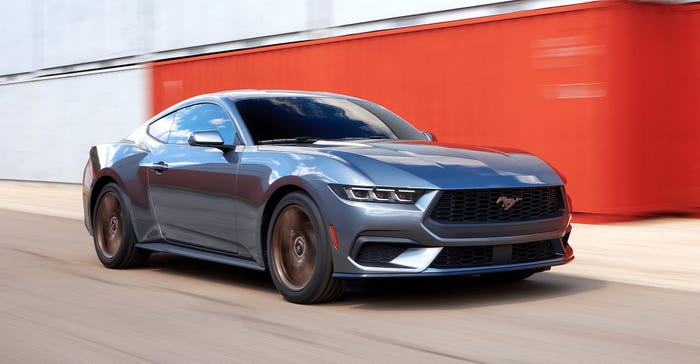Ford’s Tech Updates for the 2024 Mustang
The Mustang has been around a while – since 1964! – but Ford has ample new technology for the latest model.

2024 Ford MustangFord Motor Co.
Ford has updated its venerable Mustang sport coupe in what the company describes as the seventh generation of the car. In truth, the 2024 version is a light restyling of the existing platform, with a dose of new technology added to sweeten the deal.
So while the underlying platform is still there, and the car carries over versions of its turbocharged 2.3-liter EcoBoost I-4 base engine and the 5.0-liter V8 for the GT, these engines do enjoy a bit more power thanks to their continued improvement.
That means an extra five horsepower, at 315 hp for the EcoBoost, and 30 more horsepower for the GT’s V8 engine, which is now rated at 480 hp. An optional active-valve exhaust that flows more freely adds six more horsepower to the GT’s total, and in the Mustang Dark Horse edition, power peaks at 500 hp.
The standard automatic transmissions make Mustangs with either engine a 10-speed, just like the racing-style bicycles of the ‘70s, while a six-speed manual transmission is available in the GT and Dark Horse. The GT, which I drove, employs a Getrag MT-62 transmission, while the Dark Horse’s 6-speed is a Tremec TR-3180.
The EcoBoost engine and its automatic transmission are unremarkable, delivering turbocharged power through smooth gearchanges. Alas, it seems like the calibration engineer doesn’t have faith in the powertrain’s power delivery, as the throttle response is needlessly touchy, with too much power from too little pressure on the gas pedal in an obvious effort to make the engine seem stronger than it is. The confidence to deliver linear throttle response would be appreciated. And, of course, the four-cylinder’s exhaust note is uninspiring for a sporty car.
It seems the same in the handling department, where the EcoBoost’s steering seems excessively sensitive to input in an apparent effort to create the sensation of agility while the car, unfortunately, understeers heavily when asked to actually turn.
The GT’s V8 delivers both the appropriate sound and the power that the car’s fans want. Throttle response and power delivery are as smooth as the 5.0’s burbling exhaust note. The manual transmission’s six gears are placed close together in the shifter’s H-pattern gates, and the shift knob slides easily among the gears with greater precision than that of the BMW M2’s shifter.
The GT’s handling is just as good, with the ability to slice through California’s canyons effortlessly. The steering puts the car on a predictable arc through the turns and the suspension keeps it on that course. The engine and transmission make it fun to run the car through the gears while playing on twisty roads, but the V8 delivers so much torque and the suspension permits such high cornering speeds, that even on the twistiest roads it is possible to just put the GT in 6th gear and leave it there.
Similarly, the Mustang’s clutch action is perfect. The pedal effort is light, while the friction point is broad and communicative, making it easy to wheel the GT around parking lots or other tight spaces.
Inside, Ford designers have replaced the outgoing model’s retro-themed dashboard with a pair of displays. In the base models, the instrument panel display and the infotainment display are discrete, stand-alone units that resemble iPads propped on the dashboard, while the higher-trim models have a unitized screen encompassing both displays. The size of the displays and their features are exactly the same in both cases, just the upmarket version has a cleaner, more integrated appearance.
The adjustable seat and steering column make it easy to achieve a comfortable seating position, but the switches for the car’s power windows have been moved strangely far forward on the door armrests, making them quite a reach even for long-armed drivers such as your reviewer.
The Mustang’s frameless windows make it hard to seal out wind noise, and as we noticed in the BMW iX, which has similarly frameless windows, there is wind noise around the front windows. It isn’t intrusive, but compared to so many quiet new cars, there is a bit of noise.
There are a multitude of technical features that are new for the 2024 Mustang that we highlight in the photo gallery.
About the Author(s)
You May Also Like





